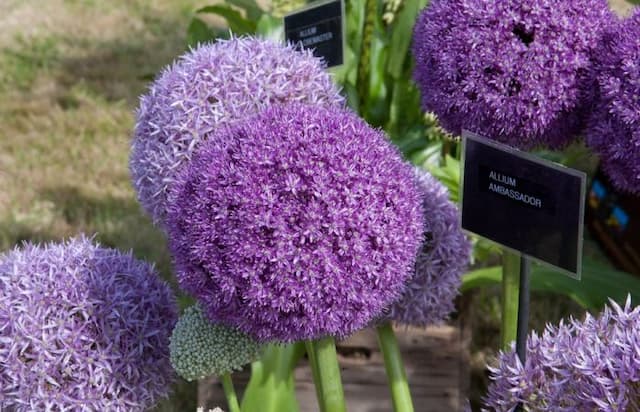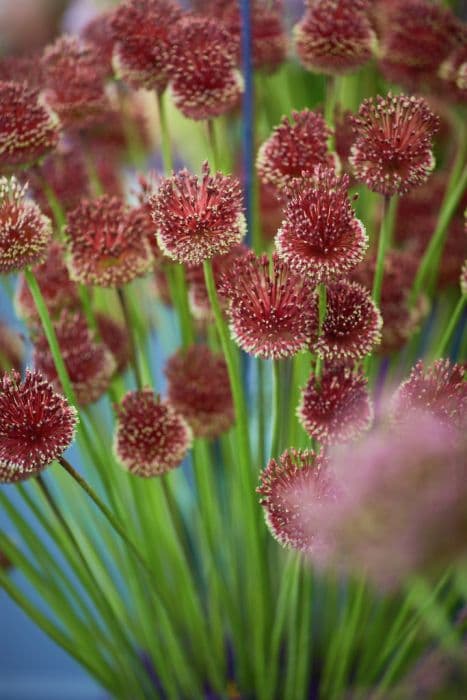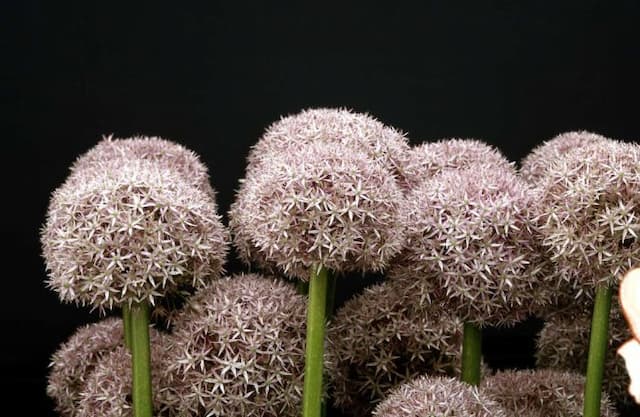Chives Allium schoenoprasum f. albiflorum











ABOUT
Allium schoenoprasum f. albiflorum, commonly known as chives, is characterized by its slender and tube-like green leaves that are hollow inside, resembling small green tubes. These leaves are typically finely pointed, emulating the shape of a delicate grass strand but with a more robust and firm texture. The plant is cherished not only for its culinary uses but also for its charming white flowers which form in dense, globe-shaped clusters atop slender stems. These soft blooms create an attractive contrast against the green of the leaves, lending a whimsical and ornamental feel to the plant. Chives often evoke a sense of fine, feathery foliage that gently sways in the breeze. It is important to note that the chives' visual appeal is not solely determined by its dimensions, as its allure lies in the fine details and color contrasts.
About this plant
 Names
NamesFamily
Amaryllidaceae
Synonyms
White-flowered Chives, Albino Chives, White Chive
Common names
Allium schoenoprasum var. albulum Regel, Allium schoenoprasum var. sibiricum L.
 Toxicity
ToxicityTo humans
Chives (Allium schoenoprasum f. albiflorum) are not toxic to humans and are in fact commonly used as a herb in cooking. Eating chives in normal food amounts is considered safe for most people, and there are no well-known toxic effects from consuming them as part of a balanced diet.
To pets
Chives (Allium schoenoprasum f. albiflorum) are toxic to both cats and dogs. If pets ingest chives, the consequences can include gastrointestinal upset such as vomiting and diarrhea. More seriously, ingestion can lead to oxidative damage to red blood cells resulting in symptoms of hemolytic anemia, which may manifest as weakness, lethargy, pale or yellow gums, and rapid breathing. Severe cases of toxicity may be life-threatening, thus prompt veterinary attention is advised if a pet consumes any part of the chive plant.
 Characteristics
CharacteristicsLife cycle
Perennials
Foliage type
Deciduous
Color of leaves
Green
Flower color
White
Height
1 feet 4 inches [40 cm]
Spread
0 feet 8 inches [20 cm]
Plant type
Herb
Hardiness zones
3
Native area
Europe
Benefits
 General Benefits
General Benefits- Culinary Uses: The chives add a mild onion-like flavor to dishes such as soups, salads, and egg recipes.
- Aesthetic Appeal: They produce decorative white flowers that can enhance the visual appeal of gardens and landscapes.
- Pollinator Attraction: Chives attract bees and other pollinators, which are essential for the pollination of many plants and food crops.
- Easy to Grow: They are a hardy and low-maintenance plant, making them suitable for novice gardeners.
- Edible Flowers: The white flowers are also edible and can be used for garnishing and in salads.
- Companion Planting: Chives can be beneficial when planted near other plants as they are believed to repel certain pests.
- Culinary Versatility: Both the leaves and flowers of chives can be used fresh or dried in various culinary preparations.
- Herb Garden Addition: They are a staple in herb gardens and can be grown in small spaces such as pots or containers.
 Medical Properties
Medical PropertiesThis plant is not used for medical purposes
 Air-purifying Qualities
Air-purifying QualitiesThis plant is not specifically known for air purifying qualities.
 Other Uses
Other Uses- Chives (Allium schoenoprasum f. albiflorum) can be used as a natural insect repellent in gardens, as their strong smell is believed to deter pests.
- The flowers of chives can be used as an edible garnish, adding a subtle onion flavor and decorative appeal to salads and other dishes.
- Chives can be planted as border plants in gardens; their dense growth can help define walking paths and separate different garden areas.
- Their vibrant flowers can be utilized in floral arrangements, providing a unique, onion-like spherical shape that adds texture to bouquets.
- Dried chive flowers can be infused into oils or vinegars to impart a delicate onion flavor for use in culinary applications.
- Chive plants can serve as companion plants, promoting the growth and health of tomatoes when planted nearby by deterring aphids.
- The grass-like leaves of chives can be woven or braided to create biodegradable garden ties for supporting other plants.
- Chives can be used in natural dyeing processes; the leaves produce a range of colors from greens to yellows when used as a dye material.
- The seeds of chives, when cold-stratified, can be used in seed art or mosaics before planting due to their size and shape.
- Chive plants can be used in sensory gardens for their texture and mild onion scent when their leaves are crushed or brushed against.
Interesting Facts
 Feng Shui
Feng ShuiChives are not used in Feng Shui practice.
 Zodiac Sign Compitability
Zodiac Sign CompitabilityChives are not used in astrology practice.
 Plant Symbolism
Plant Symbolism- Protection: Alliums, in general, are often thought to symbolize protection due to their pungent aroma which historically was believed to ward off evil spirits and disease.
- Persistence: Chives (the common name for Allium schoenoprasum) are perennial plants that return year after year, representing durability and the ability to overcome challenges.
- Cleanliness: With their clean, neat appearance and the fact that they can help prevent fungal diseases, chives are also associated with purity and cleanliness.
- Courage: Their strong flavor gives them a connection to courage, as they add a powerful punch to dishes just as courage adds strength to character.
- Good Health: Considering chives are rich in vitamins and minerals, they are often associated with an emblem for health and well-being.
 Water
WaterWhite flowering chives should be watered regularly to maintain a consistent moisture level in the soil. During the growing season, water the plant thoroughly whenever the top inch of soil feels dry to the touch, which usually happens once a week. Provide the plant with about one inch of water per week, which translates to approximately 0.6 gallons for an average-sized outdoor clump. Decrease the frequency of watering as the plant goes dormant in the late fall and winter. Overwatering can lead to root rot, so ensure proper drainage is in place.
 Light
LightWhite flowering chives thrive in full sunlight and should be placed in a location where they receive at least six hours of direct sunlight each day. They can tolerate light shade, particularly in hotter climates where some respite from the intense afternoon sun can be beneficial. However, too much shade can lead to weak growth and fewer blooms.
 Temperature
TemperatureWhite flowering chives prefer a temperature range between 60 and 75 degrees Fahrenheit for optimal growth. They are cold-hardy and can survive minimum temperatures down to 20 degrees Fahrenheit, making them suitable for growing in a variety of climates. The ideal temperature conditions allow them to produce the best foliage and flowers.
 Pruning
PruningPruning white flowering chives invigorates the plant and promotes denser growth. Snip off the flower heads after they bloom to prevent self-seeding and to encourage the production of new leaves. During the growing season, regular trimming can be done to shape the plant and maintain its size. The best time to perform a thorough pruning is in early spring or after the plant has finished flowering.
 Cleaning
CleaningAs needed
 Soil
SoilChives, the common name for Allium schoenoprasum f. albiflorum, thrive best in a loose, well-drained soil mix with high organic matter. A mixture of potting soil, compost, and perlite or sand can be ideal. The best soil pH for chives is between 6.0 and 7.0.
 Repotting
RepottingChives should be repotted every 1-2 years to ensure they have enough space to grow and to replenish soil nutrients. This regular repotting also helps to divide the clumps to promote continued health and vigor of the plant.
 Humidity & Misting
Humidity & MistingChives prefer average room humidity levels; excessive humidity is not necessary. Ideally, maintain humidity levels between 40%-60% for optimal growth.
 Suitable locations
Suitable locationsIndoor
Place chives at a sunny window; water regularly for indoor growth.
Outdoor
Plant chives in full sun to partial shade; ensure well-draining soil.
Hardiness zone
3-9 USDA
 Life cycle
Life cycleAllium schoenoprasum f. albiflorum, commonly known as white-flowered chives, begins its life cycle as a seed, which, when sown in fertile, well-drained soil and given light and moisture, germinates to produce small shoots. These shoots develop into slender, hollow leaves and form bulbs underground in the vegetative growth stage. After vernalization, a process requiring a period of cold to initiate flowering, the chives produce round umbels of white, star-shaped flowers on stalks that rise above the foliage. Following pollination, often by bees and other insects, the flowers develop into seed heads that contain black seeds. These seeds mature and, once released from the plant, have the potential to disperse and germinate to begin the life cycle anew if conditions are suitable. Throughout their life cycle, chives enter a period of dormancy in the winter, during which the above-ground foliage dies back, with the bulbs remaining dormant underground until the conditions are favorable for new growth in the spring.
 Propogation
PropogationPropogation time
Spring-early summer
Propogation: Allium schoenoprasum f. albiflorum, commonly known as white-flowered chives, is typically propagated by division, which is the most popular method for this plant. Division should be done in the spring or early fall. When the clumps of chives become dense, they can be lifted from the ground and carefully separated into smaller clumps using hands or a sharp knife. Each division should have a good amount of roots attached. Afterward, these smaller clumps can be replanted into well-prepared soil, spacing them about 8 to 12 inches (20 to 30 centimeters) apart to allow sufficient room for growth. It's important to water the new plantings thoroughly to help establish them. This method of propagation ensures genetically identical plants and is quick and reliable for gardeners who wish to expand their crop of white-flowered chives.









